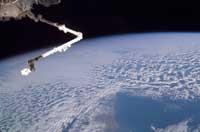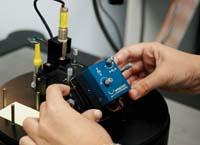From space, directly to our life
2010/02/20 Lakar Iraizoz, Oihane - Elhuyar Zientzia

Space agencies spend millions and millions on their missions and projects. The European Space Agency (ESA), for example, obtained in 2008 a budget of 3,028 million euros. We pedestrians take advantage of some of these investments. A clear example is GPS systems or weather predictions (performed via satellites that revolve around the Earth).
However, in the technologies developed by space agencies we have also achieved non-satellite uses, some of which have served our daily lives. Last year, at the end of the year, ESA published a book to present the transfers that have been made in recent times related to space technology: Down to Earth: How space technology improve our lives.
This publication includes, for example, the uses that have been given to the sensors of a robotic arm of the International Space Station (ISS). The robotic arm is used on the ISS to move large components and modules, in which tactical sensors have been placed to measure pressure to avoid collisions and accidents.

These sensors have found countless uses for the earth, such as the activation of airbags in cars. They are also used as elder care resources: for example, during the night, caregivers can know if the caregiver has risen from bed.
In another example, the ESA publication explains that space technologies have facilitated the lives of diabetics. In fact, they have developed a pump that introduces insulin itself. The pump is wrist-shaped with a small needle that patients carry under the skin and periodically injects a dose of insulin. Well, the electricity necessary for the operation of the pump is generated only with the movement of the patient, since it contains the piezoelectric materials developed for the study of the space. These materials are able to capture the energy of body movements and transform it into electricity.
On the other hand, and in order to give a more banal use, they have also developed a way of measuring the quality of hams based on space technology. It seems that one of the best indicators of ham quality is the amount of meat water. To be properly cured, the hams must contain a certain amount of water, not too much, not too much.

Well, they have developed a tool that performs this work, based on a tool to detect the movements of liquids that occur in the body of astronauts. In space travel it is important to control the fluid receding of astronauts, as in microgravity conditions the body fluids tend to rise.
The search for new uses is called technology transfer and is something that is done actively. As explained by ESA, there is a group called Technology Forum in which different types of users are grouped: on the one hand, space agencies, offering the technology they have developed, and on the other, researchers from different professional sectors, looking for solutions to meet the needs they have at that time. As those at ESA say, "the most effective innovation is to use technologies already invented for tasks they did not have for themselves."
Published in Ortzadar

Gai honi buruzko eduki gehiago
Elhuyarrek garatutako teknologia





